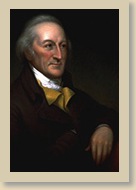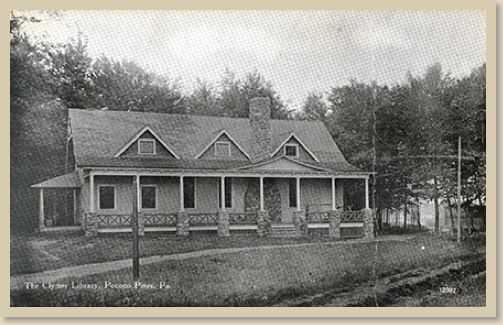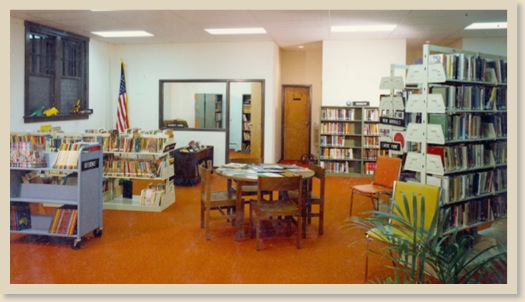By Rick Bodenschatz
(Clymer Library Trustee)
September 2012
Libraries are a result of caring people coming together to form a resource for collections of literary materials, benefiting the community it serves. In 1906, the community of Pocono Pines benefited from such an endeavor when the Clymer Library began its long legacy.
In 1901-1902, Rev. Rufus W. Miller founded, with supporters and investors, the Naomi Pines Assembly and Summer School. Based upon the “Chautauqua Movement,” it was designed to provide adult education in the arts, humanities, sciences and non-denominational Christian education and worship. For the 1903 summer season, it opened with the Pocono Pines Inn, Blakeslee Hall and an auditorium, overlooking Naomi Lake. Over the next few years it added several buildings for activities, support and summer living quarters.
The Clymer Legacy
As an accomplished minister, Rev. Miller had far-reaching associates and friends. One of importance was the Clymer family of Riegelsville, approximately nine miles from Miller’s hometown of Easton. Their friendship and vision resulted in the donation of funds by the Clymers to build a library at the new Assembly.
Born on April 2, 1863 and educated at Lafayette College in Easton, Lee S. Clymer became a successful chemist. In 1885 he opened his own general laboratory in Reading, later taking a position with the Carnegie Company, and then a number of other firms in the iron industry in his quest for success. In 1895 he erected and successfully operated the Durham Knitting Mills in Riegelsville. He later became interested in the breeding of horses and thoroughbred cattle, and became half owner in the Lehigh Power Company of Raubsville. Along the way he met Clara Matilda Riegel, and they were married on June 11, 1891. They had two children, John Riegel Clymer and Valerie Smith Clymer.
 |
Lee Clymer was of very distinguished family heritage.
His great-great uncle, George Clymer, was a signer of the Declaration of Independence and the U.S. Constitution, and there is a statue of George in Constitution Hall in Philadelphia. His great-grandfather, Daniel Clymer, was a lieutenant colonel in the Revolutionary War, and before the family emigrated to the Colonies, his great-great grandfather William Clymer sailed on the famous frigate “Penzance” for the English Navy in the mid-1700s, and he was eventually lost at sea. |

The Clymer Library at Pines Assembly, circa 1906-1920
The organization and development of the Clymer Library continued its success. On July 30, 1914, it was registered with the State of Pennsylvania effective September 8, 1914. That incorporation charter is still in effect and active today as the Clymer Library Association of Pocono Pines. The names on the new charter were:
|
|

Transition around the library
Over the years the complexion of the Assembly and its facilities changed. By 1910, financial difficulties drove the Assembly to cease operations. Creditors reorganized the complex into a commercial resort operation, while some programs were conducted for summer youth education. As World War I wound down, the U.S. Army contracted to use the facility for a vocational rehabilitation center for veterans.
In 1926, the Missouri Synod of the Lutheran Church purchased the facility for a new camp and conference center called Lutherland. It operated until the late 1930s, when due to financial challenges, it became a quasi-commercial resort under the name Pocono Crest. In the late 1950s, Valparaiso University, an independent Lutheran institution in Indiana, took control of the property.

During the Lutherland years into the Pocono Crest years, the library was known to have functioned as a vibrant library for the complex and the surrounding community. But with the financial difficulties looming, Valparaiso University saw better opportunities. Since the library association owned the books and fixtures but not the building, in 1958 the library was ordered to vacate the building so the university could turn it into a theatrical playhouse.

With no home, the library association was given space for its books at the Tobyhanna Township Elementary School on Old Route 940. At least the patrons had access, but it was limited to school hours during weekdays, with no library hours in the evenings, on weekends or in summer.

A new home at the firehouse
As the township grew in the 1960s, the library association was informed that there was no longer space for its books in the school, so the Clymer Library once again had to seek a new home.
One was found just a short distance down the street at the Tobyhanna Township Firehouse on 115 Firehouse Road. This facility housed the fire department, trucks and equipment on the first floor. On the second floor it housed the police department, township supervisor’s office, township secretary office, meeting room and a kitchenette, restroom and storage room.
So spaced was carved out of the second floor offices, with book carts and “brick and board” shelves housing the assets of the Clymer Library. During library hours, the book carts were wheeled into the meeting room for patron access. Initially, the library was only open for one evening a week, on Tuesdays. The library was anything but quiet, as folks came and went doing business with the township offices. And then the fire siren stole any sense of serenity as it blew for testing every evening at 7 p.m.
Lillian Judge served as president of the Clymer Library Association from 1972 to 1974, with Barbara Costa and Vivian Miller volunteering countless hours to serve the library patrons. Lillian also served as librarian. Sadie Christman, Pocono Pines postmaster, also dedicated time at the library and baked goodies for fundraising bake sales. As use of the makeshift library continued to increase, Saturday hours were added so school children could use it.
Clymer was one of five public libraries in Monroe County, and each year it received county funding of $1,000, then later $3,000, which was used to purchase books. The township continued to provide space for no charge, nor did it charge for utilities, insurance and other overhead costs for the library’s use of the building.
In the mid-1970s through the early 1980s, Bea and Keith Kingsbury added their educator experience in professional leadership of the library. Hours of operation were increased by a few hours a week, but it still did not meet the state’s minimum standards for state funding. Bea assumed the president’s role of the association in 1975. As the township grew, the township government received a grant to build a new administration building and police quarters, and so the library was allowed to assume the entire second floor space for continued growth.
During this same period, beginning in 1975, a group of ladies headed by Vivian Miller and Jacqueline Schoettle launched the first major library fundraiser, “A Christmas Bazaar,” on the first floor of the firehouse. With the help of the fire department and chief Barry Wierich, $900 was raised at the bazaar from the sale of donated items, of which many were handmade. The bazaar continued to be held in subsequent years, and brought in as much as $5,000 for several years.


A real library once again
Continued growth of the township resulted in the fire department’s relocation to new facilities in 1980. The timing of this was crucial, since the library association was starting to consider the need to search for a new, larger home. The township government made the entire firehouse building available to the library association under a nominal lease arrangement. The library association accepted a bid from Carroll Construction for $60,000 to renovate the first floor into the new library. The newly renovated library opened for business in 1982. The township paid for the renovation and the library association paid for all the furnishings and shelving.
By this time, the inventory had grown to 6,000 books. The volunteers and board of trustees, with leadership from Bea Kingsbury, were determined to bring the library up to standards. With a lot of hard work by all, the library was able to join the Easton Area Library District as part of its quest to obtain state funding.
In two years, a volunteer staff catalogued 4,000 books — Jacqueline Schoettle enrolled in a home college course for “Descriptive Cataloging” and shared this knowledge with the others; Beth Parker, the newly designated librarian, and Pat Hannon were instrumental. Jackie subsequently enrolled in another home college course on children’s literature, and began a Pre-School Story Hour for children ages 3-5. A Summer Reading Program was also started for school-age children.
Jackie served the library as board president from 1982 to 1986, as the standards of the library continued to improve. A book committee of local residents from a variety of backgrounds was formed to advise the library of what books should be purchased. Pat Hannon was then designated the librarian.
Keith Kingsbury served as board president from 1986-1993, and introduced the library to the computer. Keith instructed the staff to the new computerized checkout system with a Circulation Plus program. Pat Hannon continued as librarian, working diligently and maintaining a wonderful working relationship with the staff of the library.
Through 1988, the library grew to host a collection of 12,000 books, and circulation continued to grow. More space was needed for not just books, but for the patrons. A consultant was hired, who found that further expansion would be necessary if the library was to adequately serve the residents of Tobyhanna Township. In early 1991, contracts were awarded for additions to the old firehouse, increasing the size from approximately 1,800 square feet to almost 5,000 square feet.
To the west, a reading room and enlarged reference area were added, and to the east, restrooms, storage and a new entrance were built. In the center, a new circulation desk, librarian’s office and kitchen area for volunteers expanded operations. The heating, ventilation and air conditioning systems were upgraded, while electrical services, basement storage and parking upgrades were also improved. A modern design utilizing an open truss ceiling with skylights made the newly remodeled and expanded facility a pleasure to visit.

Major expansion for the 21st century
The largest growth in the history of Tobyhanna Township and all of Monroe County was occurring in the late 1980s and 1990s, and was projected into the next millennium, and demands on the resources of the Clymer Library increased dramatically. The board of trustees had a vision that recognized its obligation to this larger community. And neighboring Tunkhannock Township, also growing and with no public library for its residents, inquired about participation in the Clymer Library.
With the addition of Tunkhannock Township’s residents into Clymer’s service responsibilities and the overall growth, it was apparent to the board that increasing demand for library services would have to be met with an increase in funding.
Under the Pennsylvania State Library Law, provisions are made for the public to decide, through a referendum vote, to fund their community, public library with a library tax. In 1995 the residents of both Tobyhanna and Tunkhannock townships approved a small three-quarters of 1 mill property tax in both townships to fund the library. (The tax equates to less than $20 a year on a property with a resale value of $250,000.) Although all 20 municipalities in Monroe County have a library tax, this rate for our two townships is still the lowest library tax rate in the county. With this funding, the demand could be met for new books and other resources, and an expansion of hours to service the larger community with additional staff.
During the next few years the response from the public to the expanded services of the Clymer Library was exceptional. This prompted the board to discuss plans for a physical expansion of the facilities, along with expansion of the services and resources being provided. Planning continued through 1999 under the leadership of board presidents George Braun and Terry Staph, and in May 2000, the Clymer Library Association entered into a mortgage to significantly expand the facility and its services. Mortgage payments are being paid every month, with payoff scheduled for 2020.
The newly expanded facility provides a great deal of space for the book collection, reading areas, a much improved children’s area, a patron computer services room, and a large multi-purpose room for meetings and activities capable of seating 100 people. Offices for a growing professional and volunteer staff were expanded, and the outside grounds with a garden area enhanced the entire property. Additional parking was provided since visits by patrons continue to increase.

Today’s Clymer Library
For a small, rural and mountainous community on top of the Pocono Plateau, the Clymer Library is certainly a gem. Comments from part-time residents and visitors to our resorts, such as the metropolitan areas of New York and Philadelphia, marvel at the quality of our library for such a small community.
The Clymer Library is funded by state and local taxes and donations from the community. Without the 35 volunteers who staff it, access would be greatly reduced. Experienced, degreed librarian Laura Laspee, with unmatched enthusiasm and dedication, leads the professional staff of 10, mostly part-time employees.
Many activities throughout the year provide the community with enrichment and entertainment. Children are important to the library, with programs such as children’s story hour and a lap-time series. The chess club, art shows, concerts, the Savvy Senior Center and blood pressure screenings are examples of programming. The speaker and lecture series touches residents of all ages. Community organizations use the library as a center for meetings and activities.
Clymer Library today has more than 47,000 books and 2,500 DVDs and cassette tapes. Several daily newspapers and periodicals are provided. Eight computer stations are available for patron use, and Wi-Fi internet access is provided throughout the facility for personal computers and devices. Printing, copying and fax services are offered.
The library is open six days a week, including two evenings. A complete website provides access to the library’s catalog, E-audiobooks, E-books, and links to many resources. Activities and announcements are also posted.
The vision of Clara Clymer in 1906 most certainly provides our modern world with a resource that is truly the center of our community. The Clymer Library today serves as an educational center, an activities center, a service center and a recreational and entertainment center. With more than 50,000 visiting patrons a year, the Clymer Library is the single most important resource for our entire community.
Sources:
- Historical Association of Tobyhanna Township
- Changing Times in the Poconos by E.M. Waygood, 1972,1976, and 1986 by Mary Waygood Brower
- History of Bucks County, Pa. Volume 3 by William H. Davis, 1905, transcribed by Earl Goodman, 2000 as part of the Bucks County, Pa, Early Family Project
- History of Monroe County, Pennsylvania by Robert Brown Keller, 1927
- Lutherland: A Dream Fulfilled and Memories… by Ted Suttmeier, 2007
- Naomi: A Jewel of the Poconos from 1882 by Irene Miller Gross, 1972
- Pocono Pines…Then and Now by Frederick A. Lehrer, 2010, and additional contributions by Fred
- Narrative History by Jacqueline Schoettle, December 2001

